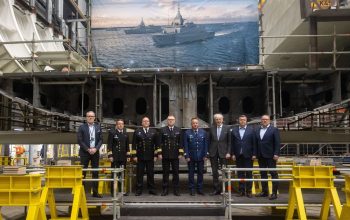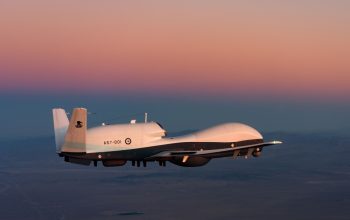Task Group Greyhound (TGG) was formally introduced by Rear Adm. Brendan McLane, commander, Naval Surface Force Atlantic, and Rear Adm. Brian Davies, commander, Submarine Group Two and deputy commander, 2nd Fleet, at an event held at Naval Station Mayport aboard the guided-missile destroyer USS Thomas Hudner (DDG 116), Sept. 27. TGG is a force generation initiative within the Optimized Fleet Response Plan (OFRP), the standard ship cycle construct that guides a roughly 36-month readiness roadmap. It is designed to provide the fleet with continuously ready, fully certified warships ready to accomplish a full range of on-demand missions 24/7/365. TGG will assign and task Arleigh Burke-class guided-missile destroyers to be at-the-ready to support sustainment operations and to counter Russian undersea threats to the homeland. The day’s event comprised of a cake-cutting, a virtual media availability, and an anti-submarine warfare scenario conducted for the official party in the combat information center aboard Thomas Hudner.
Cmdr. Bo Mancuso, Thomas Hudner commanding officer, acknowledged the importance of the initiative and of his command being selected to take the first watch. “Being chosen as one of the initial ships to serve in this capacity is humbling, and a big responsibility that we are more than ready to honor,” Mancuso said. “It was our pleasure to host Rear Adm. McLane today and show him what we’re capable of and that our crew is up to the task.”

McLane gave a Bravo Zulu to the first two TGG ships, Thomas Hudner and the guided-missile destroyer USS Donald Cook (DDG 75), and emphasized that maintaining an undersea warfare (USW) edge over Russian submarines off the East Coast is a growing priority. “Task Group Greyhound provides us a way to increase continuity between training and operating against high-end competitors in a dynamic environment,” McLane said. “These destroyers are now designated under Task Group Greyhound in the western Atlantic on watch 24/7 ready to practice, integrate, and operate at a moment’s notice.”
Facing the considerable threat from Russia requires focus, continuous monitoring and a team approach to undersea warfare. The TGG initiative will ensure that designated post-deployment East Coast destroyers remain in an extended sustainment phase on a rotating basis with other destroyers. This will be supported by incremental maintenance availabilities and sustained readiness certifications. The TGG model is a reference to the World War II destroyers, or “Greyhounds of the Fleet,” that patrolled the seas in the “Battle of the Atlantic.” The modern version is similar to how readiness is maintained aboard Forward Deployed Naval Forces in Spain. SURFLANT mans, trains and equips assigned surface forces and shore activities, ensuring a capable force for conducting prompt and sustained operations in support of United States national interests. The SURFLANT force is composed of 76 ships and more than 30 shore commands.















